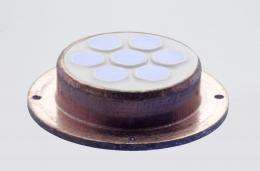Nanopores make sterile filtration more reliable

Irregular pores, low flow rates: The plastic membrane filters used in sterile filtration do not always ensure that conditions are really sterile. Filter membranes of aluminum oxide are more reliable - the size of the nanopores can be determined with precision. Even the smallest viruses cannot pass through the membrane.
The good ones are kept, the bad ones done away with - that, in a nutshell, is the principle behind sterile filtration: A filtration membrane frees liquids of unwanted particles and germs. Nothing larger than the filter’s pores, only a few ten-thousandths of a millimeter in diameter, can pass through. Conventional membranes, usually made of plastic, come with limitations: Their pores are not evenly distributed and are occasionally too wide - and particles slip through after all. Conventional filtration membranes also have virtually no way of stopping viruses: Because most viruses are smaller than the pores, this technology offers no way to filter them out.
Now, researchers at the Fraunhofer Institute for Mechanics of Materials IWM in Halle, Germany, have created a new generation of filtration membranes: They developed ceramic membranes with a uniform pore structure and a very tight and even pore size distribution. "Compared to the ceramic membranes we have seen previously, they offer better mechanical stability and considerably higher flow rates. As a result, for the first time they are also able to replace polymer membranes", notes Annika Thormann, project manager at IWM. These membranes guarantee much more reliable filtration results than polymer membranes do. Electron microscope images of the membranes prove: The pores are regularly aligned alongside one another like the honeycombs in a beehive, one identical to the next.
To produce such filtration membranes, what is required first is the right raw material: "We use highly pure aluminum that we mold to the desired shape using extrusion equipment and thermomechanical structuring", Thormann explains. But just how can you create tiny pores on an aluminum plate with such precision? "A chemical reaction does the job", Thormann says. The molded aluminum part is placed in an acid bath where anodic oxidation takes place. An oxide layer just a few microns thick forms on the surface during electrolysis. "Tiny pores form in the aluminum during oxidation," Thormann explains. These nanopores are honeycomb-shaped, vertical to the surface, and are arrayed parallel to one another. "To set the pore size, we have to keep the voltage and the concentration of the acid stable", Thormann notes. The thickness of the nanoporous layer - and hence the flow rate of the membrane itself - can be fine-tuned as well via the duration of the oxidation process. In the end, the only step remaining is to open up the pores. This step is accomplished with chemical etching to remove unneeded residual aluminum.
The result: High-precision filtration membranes with a high porosity level. "We can vary pore diameters between 15 and 450 nanometers", says Thormann. At 15 nanometers, even the smallest viruses don’t stand a chance of slipping through. The new filtration membranes are particularly beneficial to biotechnology. Aside from use of the filtration properties to produce sterile media the membranes can also facilitate tissue engineering - the cultivation of artificial tissue - thanks to their high porosity.
Provided by Fraunhofer-Gesellschaft















